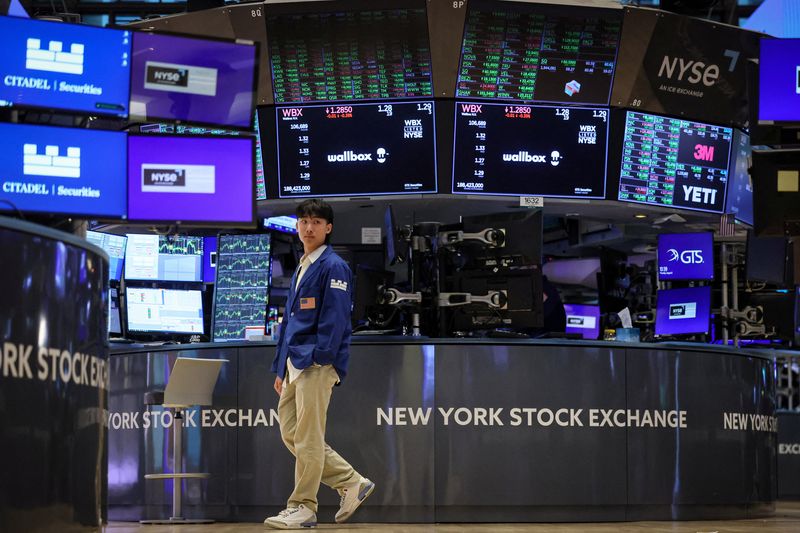[ad_1]
By David Randall
NEW YORK (Reuters) – Per week of untamed market swings has traders waiting for inflation information, company earnings and presidential polls for alerts that might soothe a latest outbreak of turbulence in U.S. shares.
Following months of placid buying and selling, U.S. inventory volatility has surged this month as a run of alarming information coincided with the unwinding of an enormous, yen-fueled carry commerce to deal equities their worst selloff of the 12 months. The continues to be down round 6% from a file excessive set final month, even after making up floor in a collection of rallies after Monday’s crushing selloff.
At difficulty for a lot of traders is the trajectory of the U.S. financial system. After months of betting on an financial comfortable touchdown, traders rushed to cost within the danger of a extra extreme downturn, following weaker-than-expected manufacturing and employment information final week.
“All people is now anxious in regards to the financial system,” mentioned Bob Kalman, a portfolio supervisor at Miramar Capital. “We’re transferring away from the greed portion of this system and now the market is dealing with the worry of great geopolitical dangers, a hotly contested election and volatility that’s not going away.”
Although shares have rallied in latest days, merchants consider it will likely be some time earlier than calm returns to markets. Certainly, the historic conduct of the Cboe Volatility Index – which noticed its largest one-day leap ever on Monday – exhibits that surges of volatility normally take months to dissipate.
Often known as Wall Avenue’s worry gauge, the index measures demand for choices safety from market swings. When it closes above 35 – an elevated degree that it topped on Monday – the index has taken 170 periods on common to return to 17.6, its long-term median and a degree related to far much less excessive investor nervousness, a Reuters evaluation confirmed.
One potential flashpoint shall be when the U.S. studies client value information on Wednesday. Indicators that inflation is dropping too steeply might bolster fears that the Federal Reserve has despatched the financial system right into a tailspin by leaving rates of interest elevated for too lengthy, contributing to market turbulence.
For now, futures markets are pricing in a 55% probability the central financial institution will convey down benchmark rates of interest by 50 foundation factors in September, at its subsequent coverage assembly, in contrast with a roughly 5% probability seen a month in the past.
“Slower payroll development reinforces that U.S. financial dangers have gotten extra two-sided as inflation cools and exercise slows,” mentioned Oscar Munoz, chief U.S. macro strategist at TD Securities, in a latest observe.
Company earnings, in the meantime, have been neither sturdy sufficient nor weak sufficient to provide the market course, mentioned Charles Lemonides, head of hedge fund ValueWorks LLC.
Total, firms within the S&P 500 have reported second-quarter outcomes which can be 4.1% above expectations, in step with the long-term common of 4.2% above expectations, in line with LSEG information.
Walmart (NYSE:) and House Depot (NYSE:) are amongst firms reporting earnings subsequent week, with their outcomes seen as providing a snapshot on how U.S. customers are holding up after months of elevated rates of interest.
The top of the month brings earnings from chip big Nvidia (NASDAQ:), whose shares are up round 110% this 12 months even after a latest selloff. The Fed’s annual Jackson Gap gathering, set for Aug. 22-24, will give policymakers one other probability to tremendous tune their financial coverage message earlier than their September assembly.
Lemonides believes the latest volatility is a wholesome correction throughout an in any other case sturdy bull market, and he initiated a place in Amazon.com (NASDAQ:) to benefit from its weak point.
The U.S. presidential race can also be more likely to ramp up uncertainty.
Democrat Kamala Harris leads Republican Donald Trump 42% to 37% within the race for the Nov. 5 presidential election, in line with an Ipsos ballot printed on Thursday. Harris, the vp, entered the race on July 21 when President Joe Biden folded his marketing campaign following a disastrous debate efficiency on June 27 in opposition to Trump.
With almost three months till the Nov. 5 vote, traders are braced for loads of further twists and turns in an election 12 months that has already been probably the most dramatic in latest reminiscence.
“Whereas early occasions recommended a clearer image of US Presidential and Congressional outcomes, newer occasions have once more thrown the result into doubt,” analysts at JPMorgan wrote.

Chris Marangi, co-chief funding officer of worth at Gabelli Funds, believes the election will add to market volatility. On the similar time, anticipated charge cuts in September might enhance a rotation into areas of the market which have lagged in a 12 months that has been dominated by Huge Tech, he mentioned.
“We count on elevated volatility into the election however the underlying rotation to proceed as decrease charges offset financial weak point,” he mentioned.
[ad_2]
Reuters
2024-08-11 13:10:34
Source :https://www.investing.com/information/economy-news/rollercoaster-week-in-us-stocks-leaves-investors-braced-for-bumps-ahead-3564005





Discussion about this post